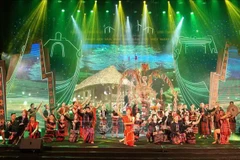Quang Nam (VNA) – Since 2008, the ancient town of Hoi An in the central province of Quang Nam has embarked on a journey of restoration, breathing new life into over 400 relic sites. This project is backed by more than 150 billion VND (6 million USD) from both the state budget and community contributions.
A World Heritage Treasure
Established in the 16th century, Hoi An was once a bustling international trading port, attracting merchants from China, Japan, the Netherlands, India and Spain. This vibrant hub has left an indelible mark on the town's architecture and culture, creating a unique blend of Eastern and Western influences.
Hoi An city boasts an impressive array of heritage sites, including 27 national heritage sites, 49 provincial relic sites, and over 1,330 others listed for protection. The ancient town itself is home to 1,130 sites, with nine classified as national heritage and eight as provincial heritage.

Traditional customs, beliefs and folk arts, such as Bai Choi singing and Ho Khoan chanting along the Hoai river, thrive, enriching the cultural landscape of Hoi An.
Visitors wandering through the narrow streets can easily encounter street vendors selling local specialties like Cao Lau, Mi Quang (Quang style noodle), and chicken rice, each dish infused with the essence of Quang Nam's countryside. Craft shops proudly display products from traditional villages such as Kim Bong woodwork, Tra Que vegetables, and Thanh Ha pottery, evoking memories of Hoi An's vibrant past as a trading port.
As night falls, Hoi An transforms into a magical realm illuminated by thousands of colourful lanterns. On the 14th day of each lunar month, the Lantern Festival turns the town into a dazzling spectacle of light and colour, drawing visitors from around the world.
With its distinct values, Hoi An Ancient Town was designated as a national historical and cultural relic by the Ministry of Culture in 1985. In 2009, it was recognised as a special national relic by the Prime Minister and listed as a UNESCO World Heritage Site in 1999.
25 years of heritage preservation and promotion
The emergency restoration project for at-risk relic sites has successfully saved hundreds of ancient houses, ensuring that Hoi An's identity is preserved for generations to come.

Traditional customs and folk arts continue to flourish, breathing vitality into the heritage. Kim Bong woodworking, Thanh Ha pottery and Tra Que vegetable villages have not only been revitalised but also become cultural tourism destinations, providing livelihoods for local residents.
Initiatives like "Old Town Night," "Walking Streets" and vibrant night markets have become magnets for tourists while promoting local culture.
Hoi An is also embracing sustainability by introducing electric vehicles in the ancient town, reducing plastic waste, and encouraging tourists to engage in environmental protection activities.
The Vietnamese Government, along with international organisations, has launched support projects, such as establishing conservation funds, holding scientific workshops, and awareness-raising training courses. However, Hoi An still faces challenges related to population pressure, increasing density and diversity of residents, and a rapidly growing number of tourists, particularly in the ancient town. The adverse effects of urbanisation and service-tourism development also pose serious risks to the town's unique identity.
In response, the provincial People's Committee submitted a proposal to the Government in March for the preservation and promotion of the values of Hoi An Ancient Town World Heritage Site until 2030, with a vision toward 2035. The goal is to develop Hoi An into an ecological-cultural-tourism city that preserves its identity while effectively harnessing its economic potential.
By integrating digital technology into tourism management and experiences, Hoi An aims to become a leading regional cultural-ecotourism destination. The city is committed to fostering international cooperation in heritage research and conservation, expanding opportunities to share its rich history and culture with the world./.




























